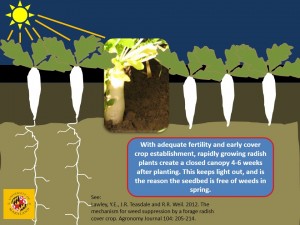A good forage radish cover crop can replace the need for early spring tillage before vegetables like spinach, beets, peas, and even carrots in some soils. Unlike high-residue cover crops like rye, forage radish winterkills and melts away in spring, leaving a warmer, dryer seedbed that is enriched with nutrients. When no-till seeding after forage radish works, it works incredibly well. When it doesn’t work, it is often a result of inadequate forage radish growth in fall or poor soil quality (poor aggregation, for instance). Soil temperature may also play a role, as tillage does increase soil temperatures.
Highly variable results seems common with many reduced tillage strategies, and it can be frustrating. Here we hope to share some of the requirements for success and common reasons for failure with no-till seeding early vegetables after winterkilled forage radish.
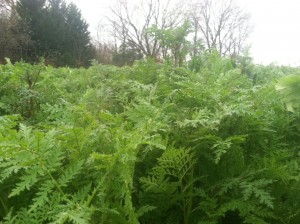
Phacelia: Some research in the 1990s pointed to good weed suppression in spring from phacelia. Seed cost is high.
We have tried other low-residue winterkilled cover crops, such as phacelia, that might serve the same cover cropping niche, but cover crops with low-residue that rapidly decompose and suppress spring weeds are not easy to find! Therefore, although there are encouraging signs that other cover crops might work for this purpose, we don’t have enough experience or data to recommend other cover crops for this system yet.
You can read the scientific publication of our research in Maryland (though we recommended checking out this website for more information and, importantly, pictures!).
Lounsbury, N.P. and R.R. Weil. 2014. No-till seeded spinach after winterkilled cover crops in an organic production system. Renewable Agriculture and Food Sytems.
We also had success with some experiments in Maine. Updates on no-till spinach and carrots in New England can be found in these blog posts:
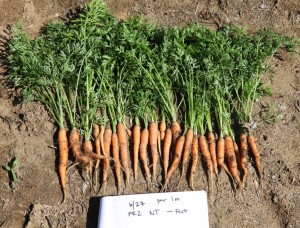
No-till baby carrots after forage radish in a sandy soil in Maine.
From small seeds to big roots: no-till organic carrots in Maine (July 28, 2014)
No-till in New England: spinach results and carrots sneak peak (June 30, 2014)
No-till vegetables in New England (June 9, 2014)
The keys to this system are:
1. Early forage radish seeding for weed suppression.
The mechanism of weed suppression by forage radish is light exclusion by the rapidly growing canopy. If you want to know the details, you can read the scientific paper by Lawley et al. They determined that in Maryland, spring weed suppression dramatically declines if forage radish is seeded later than the first week of September. The required seeding time for adequate cover crop growth to suppress spring weeds in colder climates/further north is likely earlier. In Maine, experience tells us that the last week of August is too late to get adequate spring weed suppression.
2. Adequate fall radish growth and even stands.
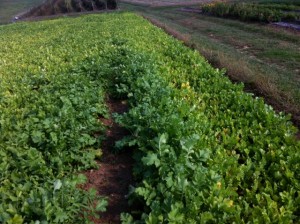
Where the radish is planted less thickly, it is visibly bigger and greener, but there is also bare soil visible. The right seeding rate is important for optimal growth and weed suppression.
Growth can be hindered if there is not enough residual fertility (radish scavenges nutrients, but if nutrients aren’t there, it can’t scavenge enough for full development), conditions are too wet (radish does not like “wet feet” and will not grow well in very wet soils), or there are insufficient crop stands. Insufficient crop stands can occur with seeding that is either too heavy (resulting in competition between plants) or too light (resulting in bare patches). Drilled seeding rates are 6-9 lb/acre, and broadcast seeding rates are 8-14 lb/acre, depending on desired density and conditions. All of our experiments were done at 9 lb/acre, but it is certainly possible to get good stands with lower rates.
For seeding with small-scale equipment (including an Earthway), see this factsheet. Radish generally establishes quickly and easily, but some care should always be taken in seeding cover crops- just like one would take care in seeding cash crops- to ensure good seed-soil contact. In dry falls, irrigating the radish (no, that’s not crazy!) can make the difference between a great cover crop stand that will facilitate no-till in spring and a very poor cover crop stand that provides few benefits.
3. Adequate soil structure in spring for cash crop growth
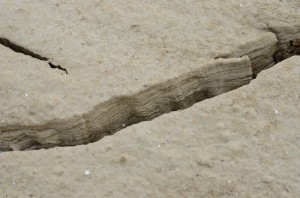
Erosion in silty soils can create a low-permeability “cap” on the surface. This is not well-suited to no-till planting, yet tillage exacerbates this problem. photo credit: Francesco Vidotto, TOPPS photo gallery
In poorly aggregated (often low organic matter) soils, rainfall can quickly compact soil or lead to soil crusts and capping. All of these can restrict cash crop growth. In these situations, tillage may be necessary to create a seedbed to support crop growth. Experimentation on your farm will determine if your soils can support no-till.
4. Effective spring seeding equipment. Forage radish leaves very little “residue” on the soil surface in spring, which means that under some conditions, it is possible to seed no-till even with simple push seeders. Radish “carcasses” may get in the way, but can be easily moved out of the way.
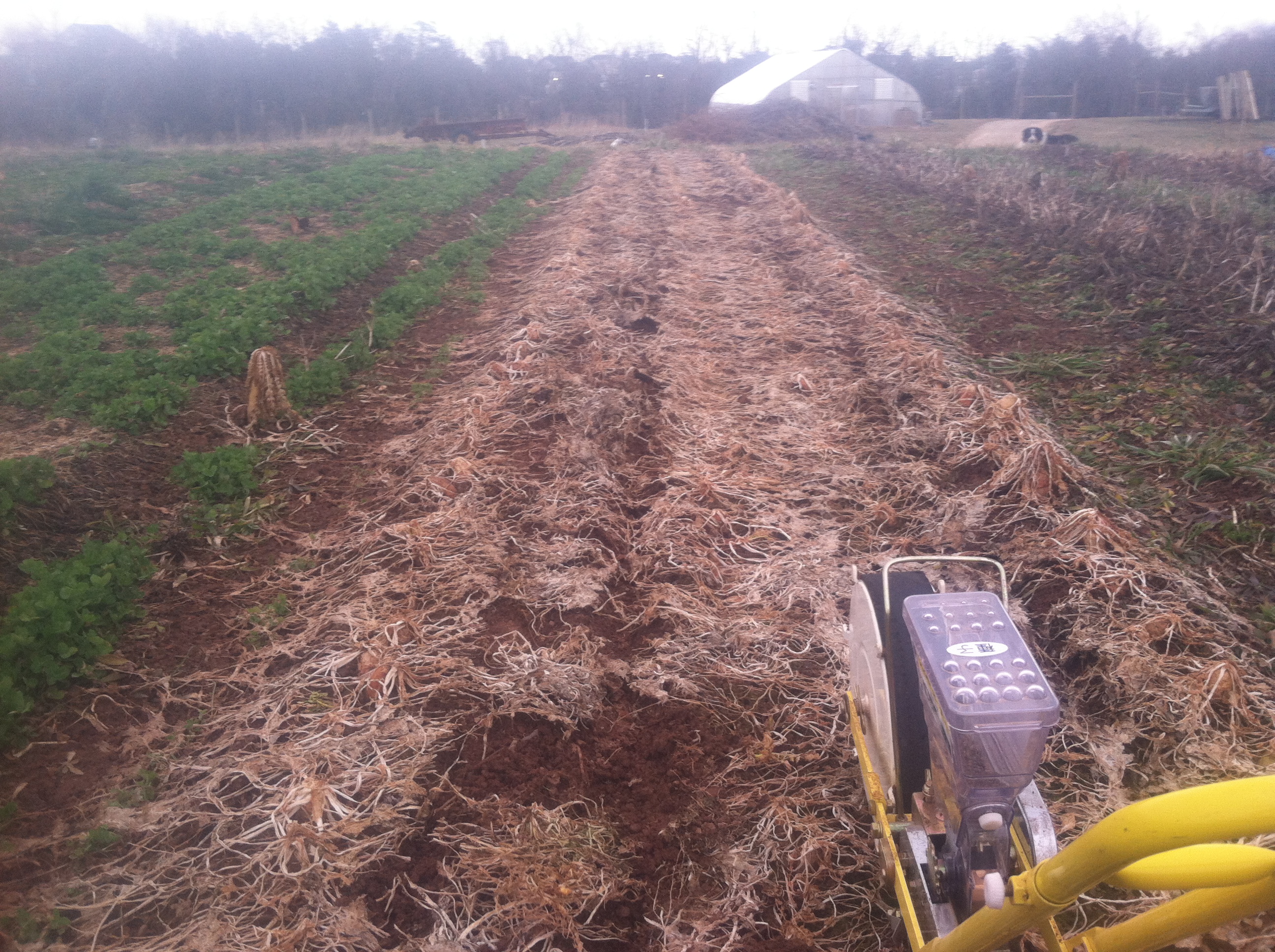
In some conditions, the Jang seeder (equipped with small double disk opener) cuts through radish “residue” easily. Photo credit: Mike Snow
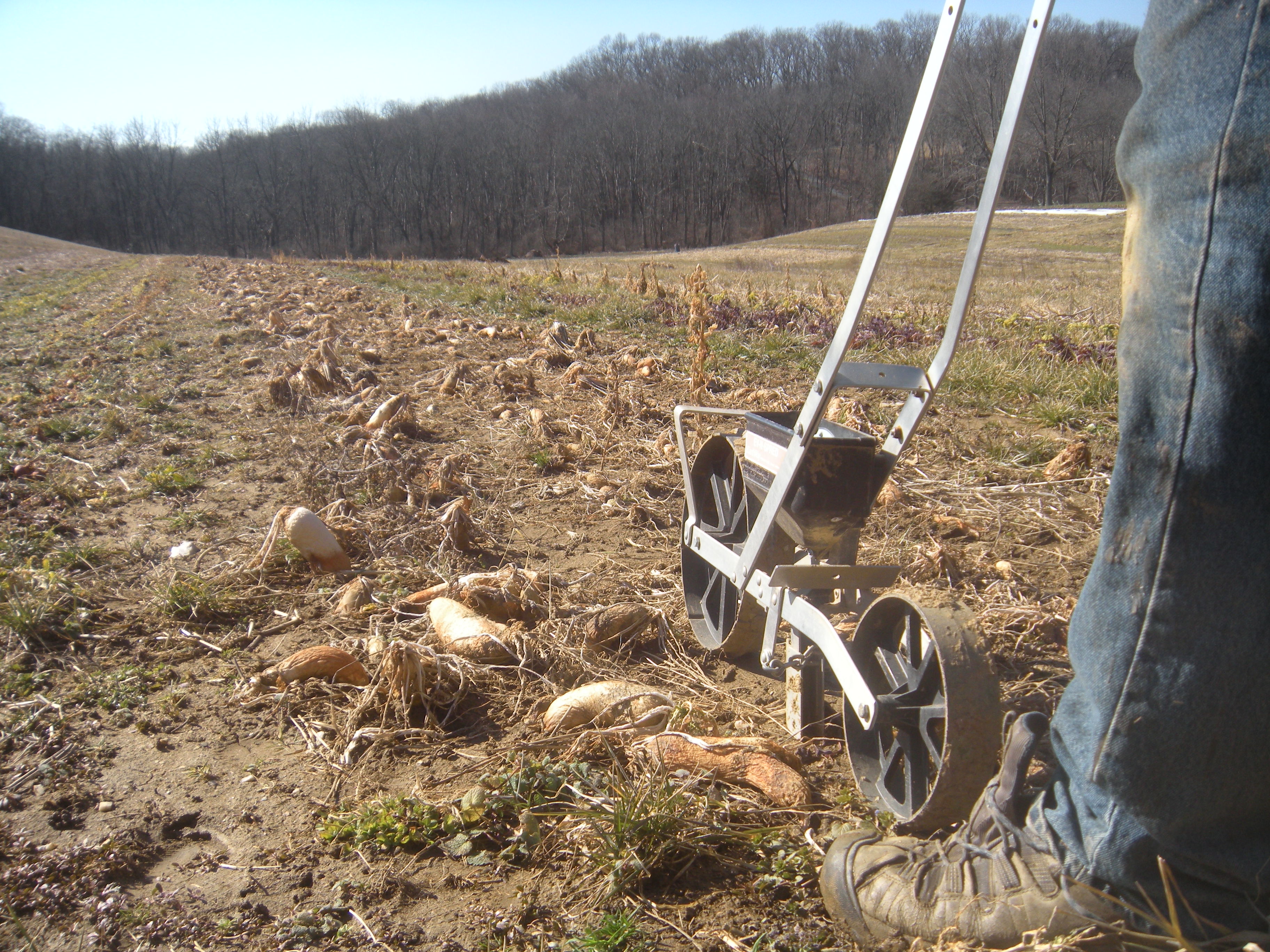
In some soil conditions, even an Earthway planter has been successful for no-till planting. Photo credit: Jack Gurley
Larger seeders with double-disk openers or coulters have no trouble with radish residue.
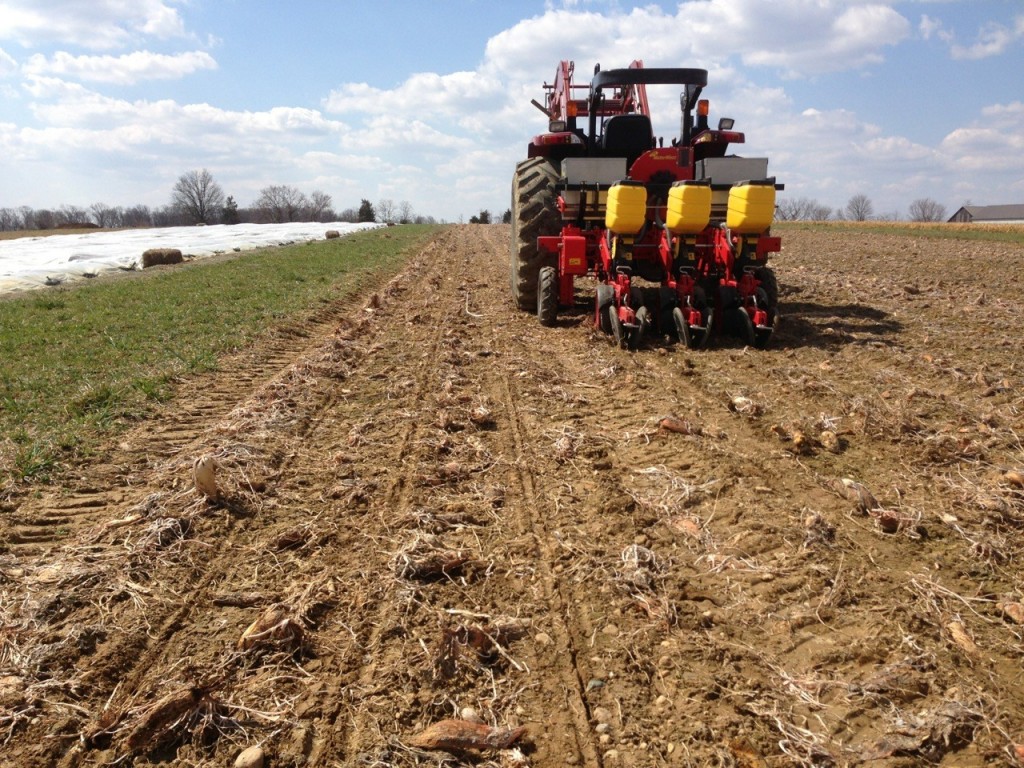
A MaterMacc seeder has no trouble planting into radish “residue.” In some soil conditions, press wheels may need to be adjusted for adequate furrow closing. Photo credit: Dave Liker, Gorman Farm
Check out these videos on seeders:
Precision seeder no-till seeding into forage radish residue:
Can push seeders plant into an untilled seedbed?
Monosem seeder no-tilling into forage radish “residue”
5. The right spring crop. We have had a lot of success with spinach, and farmers have had success with peas and beets. At least one farmer reported that carrots didn’t work very well, but we had some success with no-till seeding carrots after forage radish in a sandy soil in Maine. There may be delayed maturity of some crops with the no-till seeding. We experienced this with some lettuce trials. The variability in results goes to show that every farm and every season is different, and the only way to find out if it will work on your farm is to try. Just remember to have “control” plot for comparison!
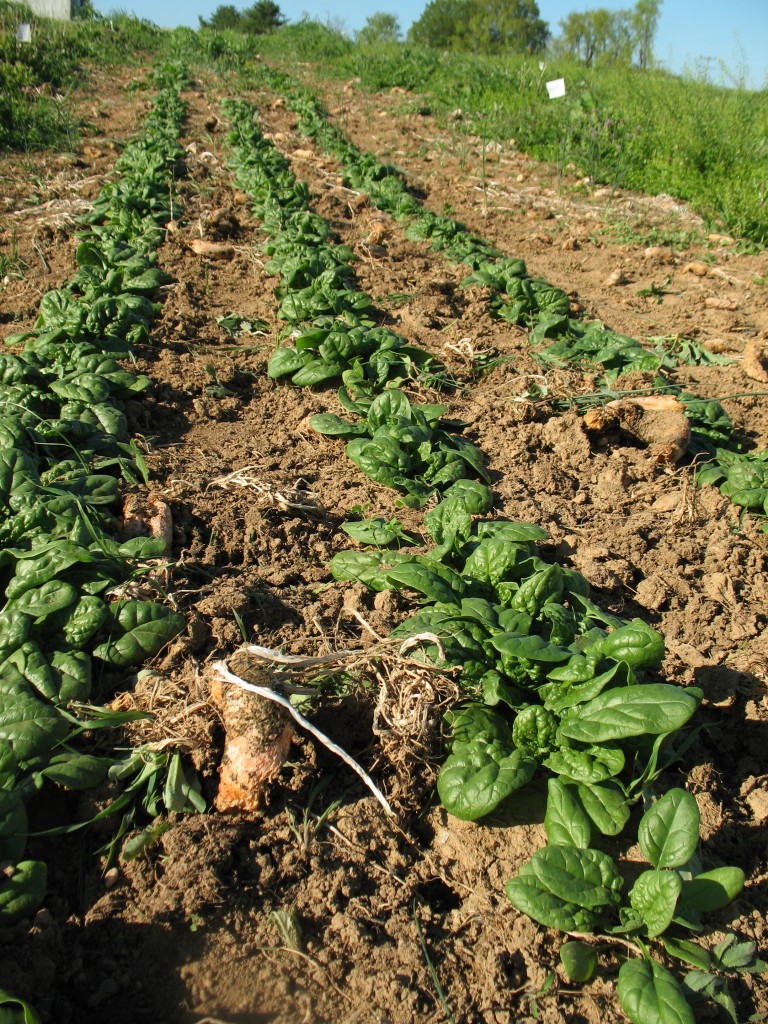
This no-till spinach was planted after forage radish with a Monosem planter and had higher yields than all of the tilled treatments. Notice the weed pressure in the no cover crop pathways on either side. The few weeds in the forage radish no-till plots were easily hand-weeded. Mechanical weeding might present some difficulties because of the radish “carcasses” and uneven surface. Photo credit: Natalie Lounsbury
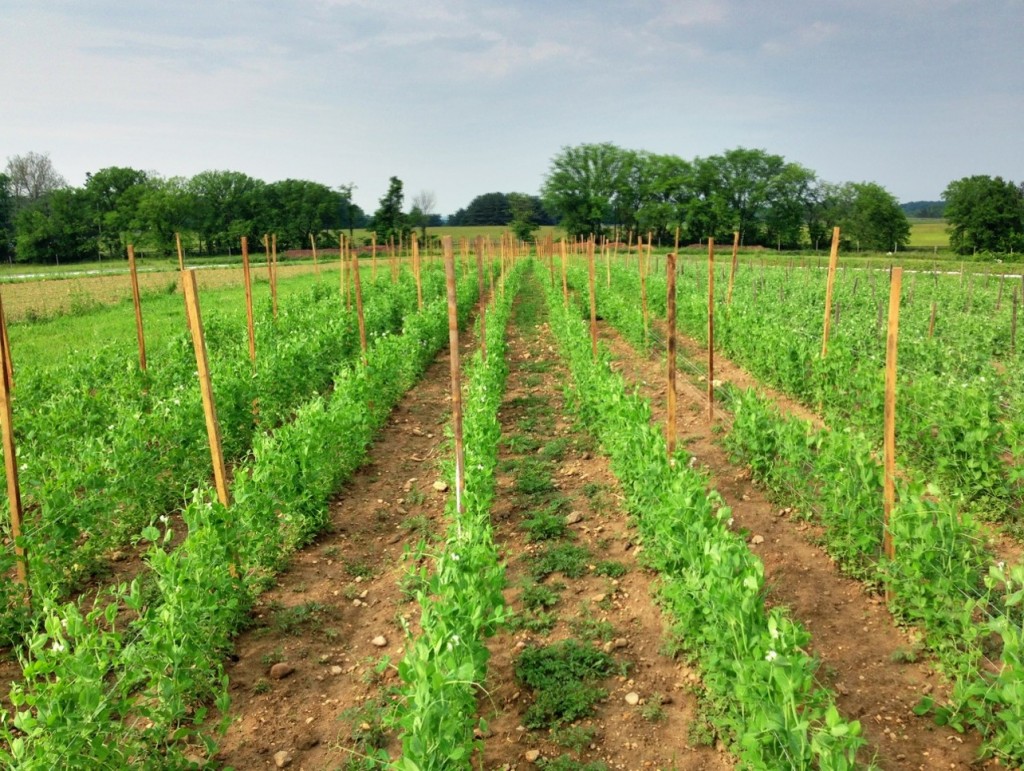
These peas were planted no-till after forage radish using a MaterMacc Planter. Weeds were minimal, but mechanical control with beet knives was only somewhat effective. Photo credit: : Dave Liker, Gorman Farm

The no-till lettuce (left) was delayed 1-2 weeks compared to the lettuce that was planted after tillage (right) in a cold spring (2012). Photo credit: Ray Weil

